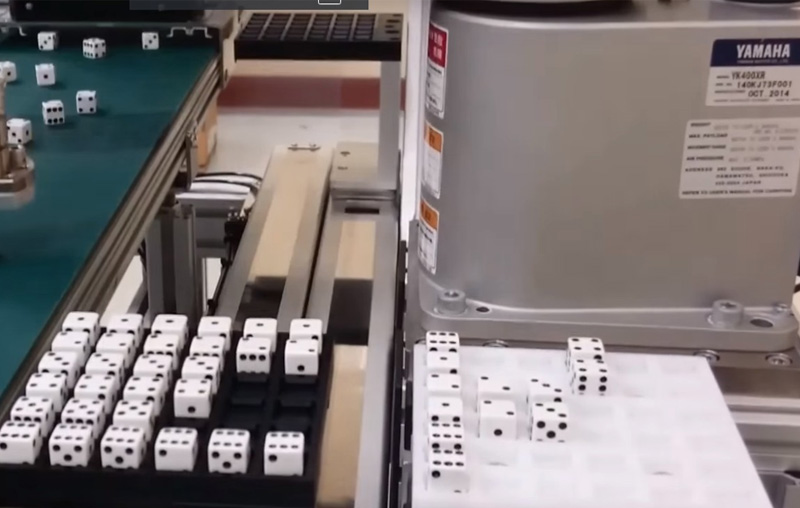Big data and advanced analytics are entering the electronics manufacturing scene, and are set to become essential tools for informed decision making throughout the business, from managing equipment in real-time to securing continuous improvement and determining high-level business strategies
CHALLENGES FOR MANUFACTURERS
Running a profitable manufacturing enterprise is increasingly challenging. Costs and revenue are both constantly under intense pressure, while tough competition both locally and globally mean that margins are slim and there is little room for error.
The data generated by automated assembly equipment can provide answers to manufacturing challenges. Each time a stencil is loaded, a squeegee blade passes, a nozzle picks and places a component, and an assembly is inspected, sensors such as position sensors, force sensors, nozzle-mounted cameras and inspection cameras capture information that intimately describes the health of assembly equipment, the stability of processes such as screen printing and component placement, and the characteristics of components and materials that determine the manufacturability of the product and the end of line yield.
Capturing that data is one hurdle. Turning the raw material into insights that can be actioned to solve problems and improve the results measured at the end-of-line is a task that has mostly been left to SMT line-management software. Until now.
Various line-management packages, such as Yamaha’s Factory Tools suite, have helped operators, production supervisors, and planners to assert control over inline SMT equipment and thus enhance utilization, efficiency, and productivity. Typically included are tools to assist machine programming and line balancing, and monitor production in real-time. Line-monitoring software such as Yamaha’s M-Tool lets managers view equipment status at a glance and helps ensure that components and feeders are replenished at the right time to avoid unnecessary stoppages. In addition, tools such as Yamaha’s QA Options and Mobile Judgement smartphone app indicate any No-Go inspection results and provide help to identify the cause and resume production.
BIGGER DATA, MORE POWERFUL TOOLS
There are challenges in finding the answers that are embedded in the data. Historically, analysis has been laborious, often requiring experienced members of the production team to interpret the results and hence spot unwanted trends and track down the causes of defects. This often relies on experience and “feel” for individual machines to identify the causes of problems and to anticipate maintenance issues before any equipment failure can occur.
Generating reports based on the captured data, which are often requested to assist high-level actions such as to prepare new business tenders, improve product designs, or guide investments in new capital equipment, adds to the workload of individuals and slows business decision making.
Right now, data science is in the midst of a surge in development, as companies across many sectors seeking digital transformation are demanding more data and more powerful analytical tools to help them understand what it means for their businesses. Many different types of organisations in sectors such as logistics, pharmaceuticals, food packaging, and banking, are establishing their own data cultures to discover new business insights and understand how to mitigate risks, reduce costs, increase efficiency, create better products and services, and deliver greater value for customers and stakeholders.
The latest data science is ready to help the electronics manufacturing community, too. Drawing on the best expertise in the emerging data industry, formerly manual analysis tasks can be automated to extract deeper insights more quickly and more efficiently than at any time in the past. Yamaha has teamed with Tableau Software to introduce the Yamaha Dashboard visual package, which embeds Tableau analytics software. The tools available in Dashboard provide live and historical production analytics that help visualise operating quality status, analyse the availability, performance and quality factors that constitute Overall Equipment Effectiveness (OEE), and drill deeper into the data to identify causes of problems or defects, and get help to resolve issues such as pickup errors, line-balancing problems and other bottlenecks.
OEE ANALYSIS
Yamaha’s Dashboard monitoring tools help operators keep on top of equipment status and quickly recover machines and production when needed, while floor leaders and engineering staff can use the insights to handle problems at a strategic level and take action to improve performance. At a higher level, management reporting tools provide the analysis needed to assess the current state of manufacturing capability and inform immediate and longer-term decision making.
By identifying the causes of reduced availability, performance, and quality, OEE and, ultimately, productivity, can be improved. The data analytics knowhow embedded in Dashboard can unlock the secrets to these challenges. Analysis as described in figure 1 can quantify problems and identify their causes, leading to decisions regarding the most suitable action to take.

Analiza produkcji w czasie rzeczywistym przedstawia stan maszyn i linii w sposób graficzny i szczegółowy, jak pokazano na rysunku 2. Użytkownicy mogą szybko zidentyfikować wszelkie usterki występujące na linii produkcyjnej, zobaczyć, które maszyny zostały zatrzymane i zobaczyć wpływ na OEE w miarę ich występowania.
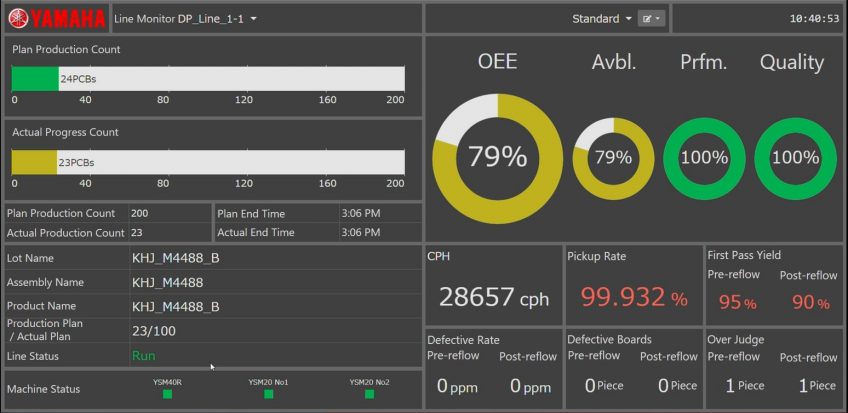
Live production analytics report the status of machines and the line graphically and in detail, as figure 2 shows. Users can quickly identify any faults occurring on the production line, see which machines have stopped, and see the effects on OEE as they happen. Historical production analytics, on the other hand, allows a direct graphical view of OEE metrics, and lets users instantly visualise down time, setup time, and errors that cause stoppages (figure 3). More detailed analysis includes the numbers of pickup errors and the events that cause the most frequent stoppages.
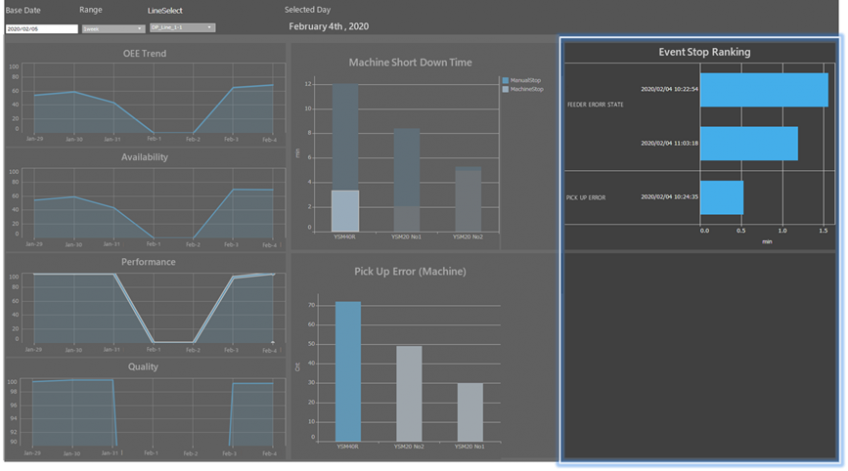
DEEPER DATA ANALYSIS
The Yamaha Dashboard contains several views that allow deeper analysis of line balancing issues, problems that cause poor component pickup, and other errors. The bubble chart of figure 4 shows how Dashboard helps easily visualise pickup statistics to identify the causes of poor performance and take action to minimise pickup errors.

Pickup analysis can also help to identify parts and heads that suffer routinely from poor performance, and can highlight the results according to feeder, head, or nozzle. Relation analysis allows users to check the number of errors experienced with other components handled by the same feeder, head, or nozzle, to determine whether the error is associated with the component or with the mounter.
ADDING IMAGE TRACING
High rejection rates often occur after visual inspection when a new component type is introduced on mounter in the line. To minimise false No-Go (NG) results from inspection, a suitable body of image data must be collected and analysed to identify any deficiencies in the reference image used by the inspection system to recognise the component.
This could take several days, after the problem is first noticed, to capture enough information from NG events to tune-out the problems with the recognition image.
Thanks to the latest powerful database tools, it is now viable to store large numbers of images associated with NG results and use these to fine-tune recognition images more quickly and efficiently. Yamaha’s All Image Tracer is a new tool designed to store all vision images continuously and hence allow analysis as soon as a problem is detected. This can help quickly identify the causes of NG results (figure 5) by eliminating the time traditionally taken to collect images after the problem has been discovered. Using this tool, engineers can also quickly optimise reference images to prevent high false-rejection rates after visual inspection.
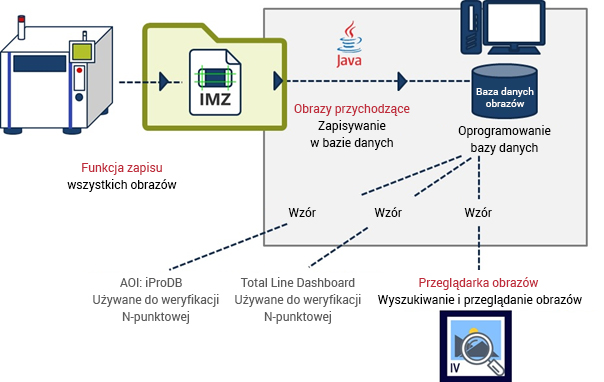
Połączenie All Image Tracer z Dashboard daje dodatkowe możliwości monitorowania produkcji, pomagając szybko zidentyfikować i rozwiązać przyczyny problemów. Rysunek 6 pokazuje, w jaki sposób Yamaha Dashboard identyfikuje często występujące błędy (pobierania), podczas gdy późniejsza analiza powiązanych obrazów za pomocą All Image Tracer pozwala na szybkie zlokalizowanie przyczyny błędu i rozwiązanie go poprzez zresetowanie wysokości (pobierania).
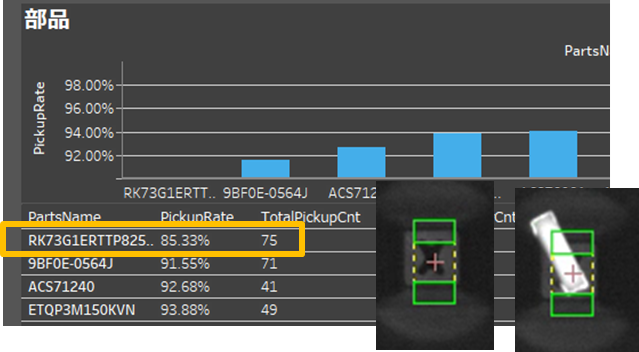
Combining the All Image Tracer with the Dashboard brings extra power to production monitoring, helping quickly identify and solve the causes of problems. Figure 6 shows how the Yamaha Dashboard identifies frequently occurring pickup errors while subsequent analysis of associated images using All Image Tracer enables the cause of the error to be quickly pinpointed and solved by resetting the pickup height.
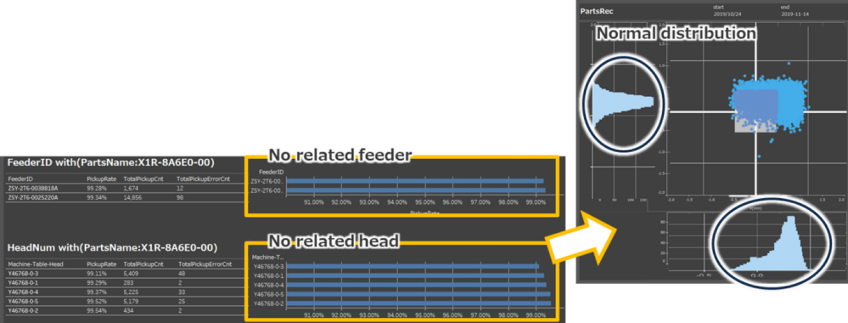
CONCLUSION
By capturing larger repositories of data and images, and leveraging automated analytics and visual tools to help read and understand the results, operators, floor managers, engineering staff and management can gain the insights they need to accomplish their objectives. These can range from quickly recovering machines or production after stoppages, to correcting errors and preventing recurrence, to high-level decisions regarding manufacturing strategies and future product design.
Leveraging the powerful Tableau analytics platform, the Yamaha Dashboard is a scalable and future-proof tool that is ready to grow with users and with the continued development of modern data science.
MAIN DISTRIBUTOR OF YAMAHA SMT ORAZ YAMAHA ROBOTICS – RENEX GROUP
The RENEX Group is the exclusive distributor of YAMAHA SMT and YAMAHA Robotics in Poland and Central and Eastern European countries. YAMAHA devices, as well as other products from the RENEX offer, can be seen and tested in operation under test conditions of production lines, also on own components and sub-assemblies, in the RENEX TECHNOLOGICAL-Training Centre. In addition to equipment, the RENEX Group provides a comprehensive range of consulting and advisory services in the field of production process automation. If you are interested, please contact the RENEX Group Technical and Commercial Advisors.
